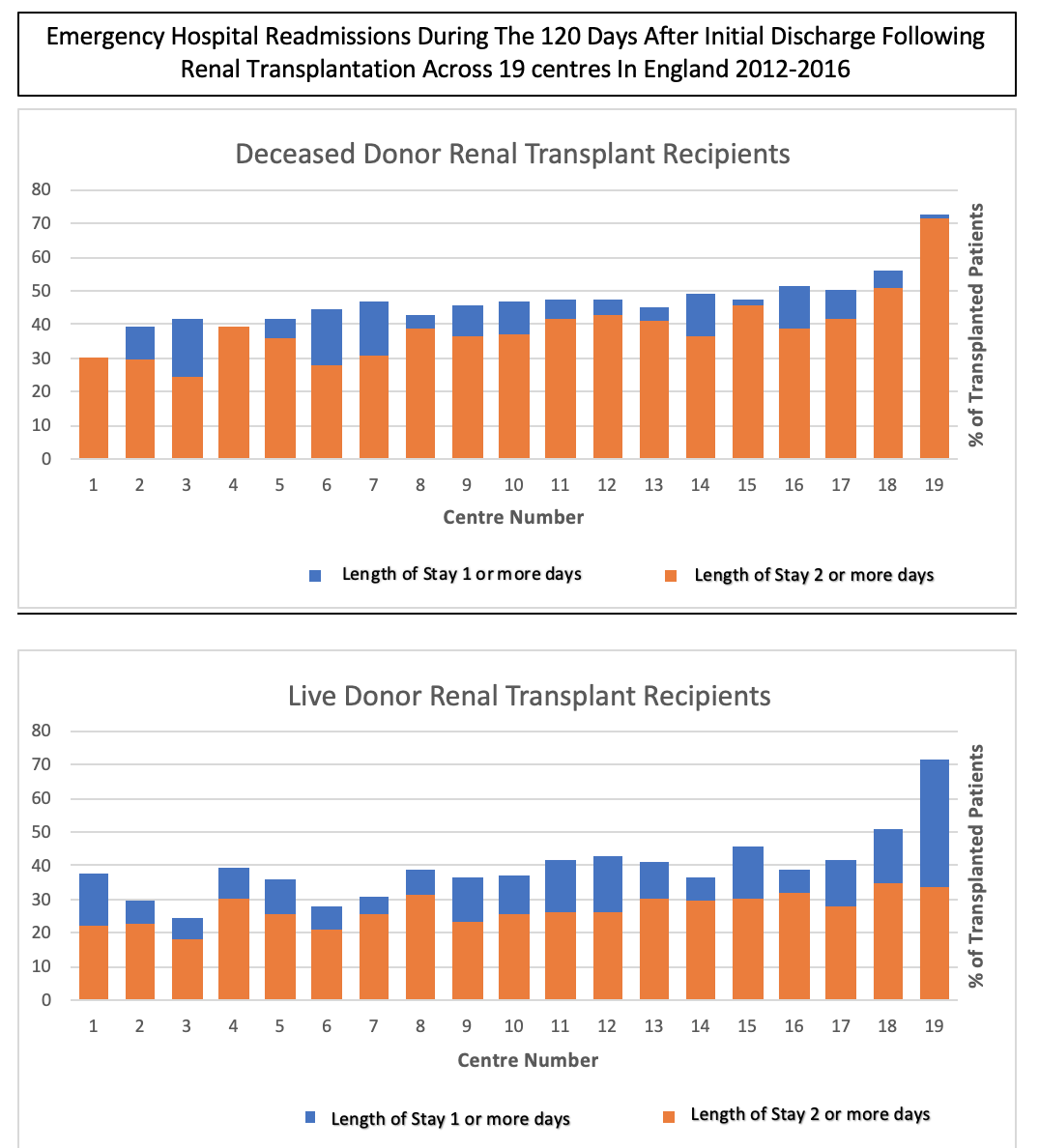Centre Variation in Emergency Hospital Readmissions Following Renal Transplantation in England
1UK Renal Registry, Bristol, United Kingdom, 2John Walls Renal Unit, Leicester General Hospital, Leicester, United Kingdom, 3University Hospitals Birmingham, Birmingham, United Kingdom, 4London School of Hygiene and Trpoical Medicine, London, United Kingdom, 5Sheffield Kidney Institute, Northern General Hospital, Sheffield, United Kingdom
Meeting: 2021 American Transplant Congress
Abstract number: 439
Keywords: Kidney, Outcome, Quality of life, Surgical complications
Topic: Administrative » Quality Assurance Process Improvement & Regulatory Issues
Session Information
Session Name: Quality Assurance Process Improvement & Regulatory Issues
Session Type: Poster Video Chat
Date: Monday, June 7, 2021
Session Time: 7:30pm-8:30pm
 Presentation Time: 7:50pm-8:00pm
Presentation Time: 7:50pm-8:00pm
Location: Virtual
*Purpose: Emergency hospital readmissions (EHR) following surgery are associated with significant patient distress, morbidity and costs to healthcare providers. In this study we aim to describe and compare, for the first time, EHR following adult renal transplantation across England.
*Methods: We undertook a retrospective analysis of linked English ‘Hospital Episodes Statistics’ and ‘UK Renal Registry’ datasets to identify EHR within 120 days of initial discharge for adult renal transplant recipients, across 19 centres (2012-2016). All elective and day case admissions were excluded. Logistic regression was used to calculate odds ratios for readmission associated with age, sex, ethnicity, deprivation, transplant type (live donor LD or deceased donor DD) and length of stay (LOS) at time of surgery. Coded primary diagnoses were also explored in an attempt to try and characterise the main reasons for readmissions.
*Results: 12156 adult renal transplants were performed in England between 2012-2016 (8299 DD and 3857 LD). 44% of patients had an EHR within 120 days of their initial discharge, varying between 30-72% across centres. Median LOS for EHRs was 3 days (IQR 2-7 days). 25% of EHRs had LOS=1 day however and variation in EHRs requiring longer hospital stays were therefore explored separately (Figure 1). Risk factors for readmission included advancing age, female sex, DD kidney and longer LOS following initial surgery. The proportion of readmitted patients with commonly coded primary diagnoses are shown in Table 1.
*Conclusions: We found high rates of EHR for adult renal transplant recipients. There was a clear centre effect noted and patient/transplant level factors will need to be explored further, alongside individual transplant unit care pathways and outpatient follow-up intensity to allow better understanding of reasons underlying this variation and how services might be best tailored to address it.
| Primary Diagnosis Grouping | % of readmitted patients with associated codes | Centre Variation (%) |
| Renal Impairment | 24.4 | 15-48 |
| Urinary tract infections | 9.4 | 4-18 |
| Gastrointestinal symptoms | 8.6 | 3-14 |
| Unspecified Complications of kidney transplant | 7.4 | 2-14 |
| Surgical Complications (including those related to wound/haematoma/surgical site infections) | 7.0 | 3-12 |
| Other infections (sepsis/chest) | 4.8 | 2-8 |
| Obstructive Uropathy | 3.4 | 1-10 |
To cite this abstract in AMA style:
Peracha J, Pitcher D, Steenkamp R, Medcalf J, Lipkin G, Nitsch D, McKane W. Centre Variation in Emergency Hospital Readmissions Following Renal Transplantation in England [abstract]. Am J Transplant. 2021; 21 (suppl 3). https://atcmeetingabstracts.com/abstract/centre-variation-in-emergency-hospital-readmissions-following-renal-transplantation-in-england/. Accessed December 18, 2025.« Back to 2021 American Transplant Congress

